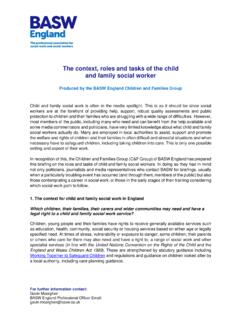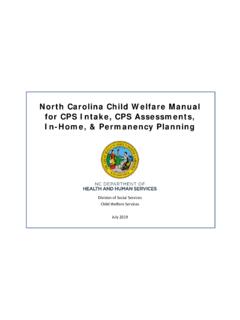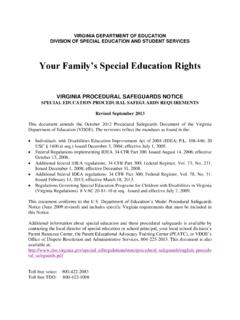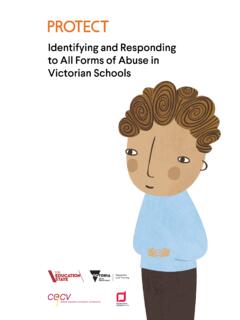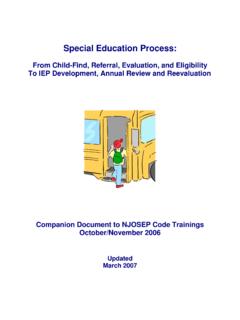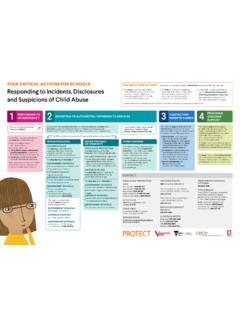Transcription of Early years foundation stage profile handbook 2022 - GOV.UK
1 Early years foundation stage profile 2022 handbook 1 Contents Section 1. Introduction 3 Purpose of this guidance 3 of the EYFSP handbook 3 information 4 Important dates for 2021/22 4 Expiry 5 Section 2. EYFS profile : purposes and principles 6 Overview of the profile 6 Principles of EYFS profile assessments 7 Building knowledge of the child 8 Section 3. Completing the EYFS profile 9 Overview 9 Exceptions and exemptions 9 Assessing children against the Early Learning Goals 9 Early Learning Goals 10 Completing the profile for children with an outcome at the emerging level 14 Completing the profile for children with a special educational need or disability (SEND) 15 Moderation 16 Section 4. EYFS profile data collection and submission 17 Overview 17 Data collection and submission 17 Responsibilities 19 Section 5.
2 Reporting the EYFS profile assessment 21 Reporting to the year 1 teacher 21 Reporting to parents 21 Transferring records to a child s new school or provider 22 Section 6. Types of school 23 How the requirements apply to different types of school 23 2 Section 1. Introduction Purpose of this guidance This publication provides guidance and advice to local authorities and Early years providers from the Department for Education (DfE). It has been produced to help teachers and Early years practitioners make accurate judgements about each child s level of development at the end of the Early years foundation stage (EYFS) and to detail the statutory requirements for the EYFS profile assessment in the 2021/22 academic year. This guidance is for: reception and key stage 1 teams headteachers and managers local authorities Status of the EYFSP handbook The main purpose of this handbook is to provide guidance for schools1 when completing the EYFS profile assessment for children at the end of reception year.
3 The handbook details the statutory duties that apply to schools as set out in the statutory framework for the Early years foundation stage . It also set outs the statutory duties on local authorities in relation to assessment and reporting, which were previously set out in the Early years foundation stage Assessment and Reporting Arrangements guidance. This publication details the statutory requirements that were previously set out in the Early years foundation stage Assessment and Reporting Arrangements (ARA) document. All previous ARA guidance is superseded by this publication. These statutory duties are indicated by the word 'must'. Additionally, schools and local authorities must "have regard" to other provisions in this guidance. These provisions are indicated by the use of the word should . "Having regard" to these provisions means that schools and local authorities must take them into account and should not depart from them unless there is good reason for doing so.
4 1 For the purposes of this document school is inclusive of all EYFS providers that complete the EYFSP. If a child has attended a range of settings during the final year of the EYFS, the EYFS profile assessment must be completed by the provider where the child spends the majority of their time between 8am and 6pm. For most children this will be a reception class in a school. 3 information Practitioners and local authorities involved in delivering the EYFS should be aware of, and refer to, the following information: The Childcare Act 2006 ( The Act ) Section 40(2) of the Act stipulates that Early years providers, including schools with Early years provision, must ensure that their provision meets the learning and development requirements and welfare requirements as specified in the EYFS (Learning and Development Requirements) Order 2007 (as amended) ( the Order ) and the EYFS (Welfare Requirements) Regulations 2012 respectively.
5 The Act states that the Order can specify the arrangements required for assessing children for the purpose of ascertaining what they have achieved in relation to the Early learning goals (ELGs). All English local authorities (LAs) must have regard to guidance given by the Secretary of State for Education in exercising their function under article 4(2) of the 2007 Order. The order is made in exercise of the Secretary of State s powers under sections 39(1)(a), 42 and 44 of the Childcare Act 2006. Failure to have regard to this guidance will breach this statutory requirement. Statutory framework for the Early years foundation stage The EYFS framework2 sets the statutory standards for the development, learning and care of children from birth to age 5. The EYFS framework sets the standards that all Early years providers, including schools with Early years provision, must meet to ensure that children learn and develop well and are kept healthy and safe.
6 It promotes teaching and learning to ensure children s school readiness and gives children the broad range of knowledge and skills that provide the right foundation for good future progress through school and life. Important dates for 2021/22 Date Activity 30 June 2022 The EYFS profile must be completed for each child and submitted to the LA no later than 30 June. 29 July 2022 Deadline for LAs to return data to DfE. 2 4 Expiry This guidance is relevant until the end of the 2021/22 academic year. 5 Section 2. EYFS profile : purposes and principles Overview of the profile The statutory EYFS framework requires the EYFS profile assessment to be carried out in the final term of the year in which a child reaches age 5, and no later than 30 June in that term. The EYFS profile is intended to provide a reliable, valid and accurate assessment of each child s development at the end of the EYFS.
7 It is made up of an assessment of the child s outcomes in relation to the 17 Early learning goal (ELG) descriptors. Practitioners are expected to use their professional judgement to make these assessments, based on their knowledge and understanding of what the child knows, understands, and can do. The EYFS profile is a statutory assessment of children s development at the end of the Early years foundation stage (known as a summative assessment). Day-to-day informal checking of what children have learnt will inform teaching and learning on an ongoing basis throughout the final year of the EYFS. This will include identifying areas where children may be at risk of falling behind, so that practitioners can provide rapid, effective support. The Early learning goals (ELGs) are what is assessed at the end of the reception year and should not be used as a curriculum. The EYFS profile is not intended to be used for ongoing assessment or for entry-level assessment for Early years settings or reception classes.
8 Purposes and main uses of the profile The main purpose of the profile assessment at the end of the EYFS is to support a successful transition to Key stage 1 (KS1) by informing the professional dialogue between EYFS and year 1 teachers. This should inform year 1 teachers about each child s stage of development and learning needs and help them to plan the year 1 curriculum to meet the needs of all children. The EYFS profile is also used to inform parents about their child s development. Children are defined as having reached a Good Level of Development (GLD) at the end of the EYFS if they have achieved at least the expected level for the ELGs in the prime areas of learning and the specific areas of mathematics and literacy. This helps teachers and parents to understand broadly what a child can do in relation to national expectations. In addition, the EYFS profile provides a national child learning and development data set at the end of the EYFS.
9 6 The DfE uses EYFS profile data to monitor changes in levels of children s learning and development both nationally and regionally, and to compare the development outcomes of different groups of children according to characteristics such as gender and eligibility for free school meals. The EYFS profile is not an accountability measure for schools and the DfE does not publish school level results for the EYFS profile . of EYFS profile assessments Reliable and accurate assessment at the end of the EYFS is: Practitioners using knowledge of children: assessment is based primarily on the practitioner s professional knowledge of what the child knows, remembers and can do day to day. It is a means of checking whether a child has learnt what has been taught (for example letter/sound correspondence) or can take place during routine interactions with children and does not need to be planned or documented.
10 The practitioner may simply reflect on the knowledge, skills and understanding that the child demonstrates in the course of everyday learning to plan what to teach next. Where something has been well taught a child s learning is embedded and secured. The child is likely to demonstrate what they know and can do consistently in a range of situations. Summative: assessment is based on a holistic view of what the child can demonstrate against each ELG at the end of the reception year. When assessing children against the ELGs, teachers should look at the whole description for each goal to determine whether this best fits their professional knowledge of the child . The ELGs are interconnected, meaning that children demonstrate attainment in more than one area of learning when engaging in a particular activity. Practitioners should consider the child s development across the areas of learning, and whether the levels of development in relation to each of the goals make sense when taken together.










